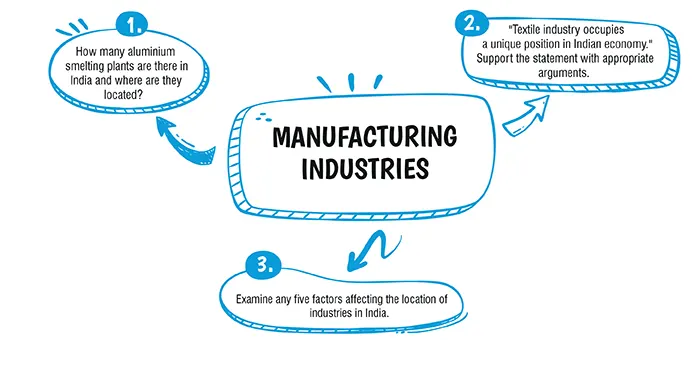

Provided here are substantial Class 10 Geography questions for Chapter 6, titled "Manufacturing Industries". These queries are meticulously crafted to serve as effective tools for student preparation, enabling comprehensive practice and the possibility of attaining noteworthy scores in the CBSE Class 10 Social Science Examination scheduled for the academic year 2023-24. Spanning a spectrum of question formats, these inquiries are strategically designed to alleviate uncertainties, foster a state of preparedness for the examination, enhance proficiency in problem-solving, and nurture a sense of self-assurance among students
Within the Class 10 NCERT Chapter 5 centred on "Manufacturing Industries" in Geography, the term "Manufacturing" signifies the creation of goods from raw materials on a significant scale. While the core focus is on production, the individuals engaged in the manufacturing process are considered secondary activities within this context. The scope of manufacturing industries encompasses a wide spectrum, encompassing establishments ranging from bakeries to steel plants.

Ans. (C)
Explanation:
Common pollutants produced by engines that burn fossil fuels are carbon dioxide, nitrogen oxides, sulphur dioxide, volatile organic compounds (VOCs), and particulates. Stoves, incinerators, and open burning produce carbon monoxide and carbon dioxide, as well as particulates.
Ans. (a)
Explanation:
The manufacturing sector is considered the backbone of development of a country.
Explanation:
There are 8 aluminium smelting plants in India, located in Odisha, West Bengal, Kerala, Uttar Pradesh, Chhattisgarh, Maharashtra and Tamil Nadu.
Explanation:
The textile industry occupies a unique position in Indian economy because :
(i) It contributes significantly to industrial production and it also provides employment.
(ii) Earns foreign exchange of 24.6%.
(iii) Its contribution towards the GDP is about 4%.
Explanation:
Factors affecting the location of industries in India are :
1. Raw Material : The easy availability of raw materials is an important factor that affects the bay (now Mumbai) had supply of cotton coming from Gujarat and Vidarbha and the jute mills of Hooghly region got the raw material from the delta region of the Ganga. The nature of raw material also has a bearing on the location.
2. Energy : Energy is another important factor that affects the location of an industry. For example, the iron and steel industry has been traditionally tied with the coal resources, as it uses coal as cooking fuel. Similarly, the electro-metallurgical and electro-chemical industries, being power intensive, have been located where electricity is easily available.
3. Transport : A cheap and effective transport system is another factor that determines the location of an industry. Transport is required for carrying raw materials to manufacturing units and finished products to the market. The earliest industries developed near the port towns of Kolkata, Mumbai and Chennai, as these ports were linked with rail and road to the hinterland. This infrastructure for transport was further developed after Independence.
4. Labour : Easy availability of cheap labour is another factor for the determination of the location of an industry. Unskilled labour is easily available in urban locations due to large rural-urban migration. One characteristic feature of labour as a factor of production is its mobility. The industrial belt around Mumbai attracts labour from all over the country. Some of the small-scale industries traditionally associated with labour are glass work (Firozabad), brass work (Moradabad), utensils (Yamunanagar in Haryana), silk sarees (Varanasi), carpets (Mirzapur), etc.
5. Market : High demand and a satisfactory purchasing power give impetus to industrial development. Government policies facilitate expansion of the market and, thus, of the industry. Markets may be local, national or international.


If you are looking to enhance your understanding of the topics discussed in this chapter, oswal.io provides an extensive array of questions carefully crafted to aid in achieving a comprehensive grasp of the concepts.
Ans: Production of goods in large quantities after processing from raw materials to more valuable products is called manufacturing.
Ans: Basic or key industries are those that provide their products as raw materials for the production of other goods. Examples include iron and steel, copper smelting, and aluminium smelting. On the other hand, consumer industries produce goods directly for consumer use, such as sugar, toothpaste, paper, sewing machines, and fans.
Ans: The jute industry is primarily concentrated in West Bengal due to several factors. The soil of the Ganga Brahmaputra delta in West Bengal is well-suited for jute cultivation, which accounts for the concentration of jute industries in this region. Additionally, West Bengal experiences a humid climate and receives substantial rainfall, approximately 200 cm, which are vital conditions for the successful growth of jute crops.
Ans: Low consumption of steel in India are because of the following reasons: High costs and limited availability of coking coal. Low productivity of labour. Disrupted supply of electricity.
Ans: Air pollution arises from industrial sources emitting smoke containing harmful gases like carbon dioxide and carbon monoxide. The contamination of water bodies occurs when untreated industrial wastewater is discharged into them. The problem of industrial pollution is exacerbated by inadequate policies and lax enforcement measures.